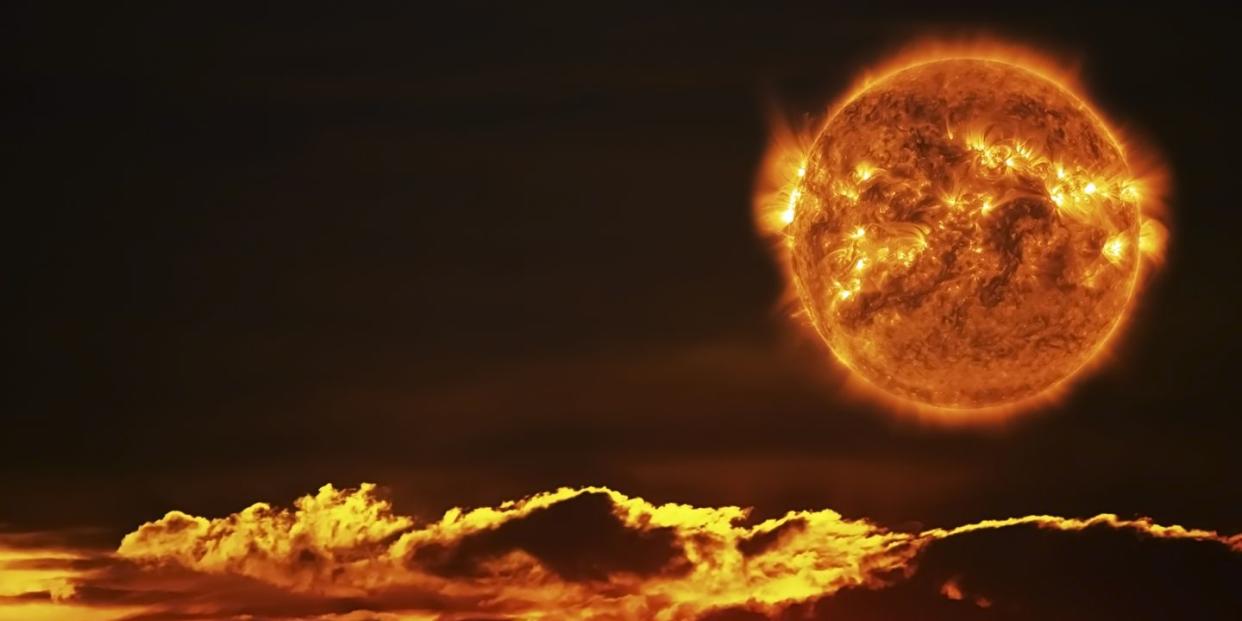Uh, the Sun Kinda Broke

NASA’s Solar Dynamics Observatory captured a northern prominence on the sun that culminated in a “polar vortex.”
This never-before-seen activity is the latest example of the sun reaching its solar maximum, and also the unsolved mysteries that surround its function.
The sun is likely to reach its solar maximum in 2024 when it will also reverse its polarity and wind back down to its solar minimum
From Earth, the sun just looks like a continuous ball of hot, but its activity actually varies wildly during an 11-year period called the “solar cycle.” The cycle begins at solar minimum, when things like sunspots and flares are rare, and ramps up to solar maximum. That’s when it gets real interesting.
Solar maximum, as its name suggests, is when the sun is at its most active, and also when its polarity flips. In December 2019, the sun reached its solar minimum and has been steadily ramping up to its maximum (likely due sometime in 2024). Now a strange, never-before-seen “polar whirlwind” provides the latest example of the sun’s journey toward maximum feistiness.
A video captured by NASA’s Solar Dynamics Observatory (and tweeted by space weather forecaster Tamitha Skov) shows a northern prominence, a dense cloud of of gas ejected into the corona, at 55 degrees latitude culminating in what Skov describes as a “polar vortex” at the north pole. Although ejections or prominences like this are common as the sun ramps up to solar maximum, the after effect of a polar vortex is highly uncommon—in fact, scientists have never seen it before.
Talk about Polar Vortex! Material from a northern prominence just broke away from the main filament & is now circulating in a massive polar vortex around the north pole of our Star. Implications for understanding the Sun's atmospheric dynamics above 55° here cannot be overstated! pic.twitter.com/1SKhunaXvP
— Dr. Tamitha Skov (@TamithaSkov) February 2, 2023
Speaking with Space.com, Scott McIntosh, a solar physicist at Colorado’s National Center for Atmospheric Research says he’s never seen a vortex like this, and that something weird always happens at the 55-degree parallel every solar cycle. McIntosh has done previous work refining the sun’s solar cycle and trying to move away from basing calculations on the increase and decline of sunspots.
“It’s very curious,” McIntosh tells Space.com. “There is a big ‘why’ question around it. Why does it only move toward the pole one time and then disappears and then comes back, magically, three or four years later in exactly the same region?”
This “vortex” or “whirlwind” only shows us how little we know about the giant electromagnetic dynamo that makes all life possible. Part of the reason why we’re limited in our solar understanding is that scientists only have one good direction at which to look at the sun: the ecliptic plane.
That means scientists have to send expensive orbiters in different inclinations around the sun in order to analyze its poles. The joint NASA-ESA Ulysses mission in the 1990s offered a rare look at the sun’s poles, which initially helped discover that the sun’s magnetic field flipped every 11 years.
On February 10, 2020, (which was a particularly well-timed moment to leave the planet) ESA sent the Solar Orbiter on a 9-year journey to reach its 33-degree inclination trajectory around the sun in an attempt to answer some of these lingering questions. However, it’s unlikely that such a mission will answer the mystery of this unexplained vortex, McIntosh says.
Even though it’s the brightest thing in the sky, there are many questions that still need answering about the big ball of hot we call the sun.
You Might Also Like
